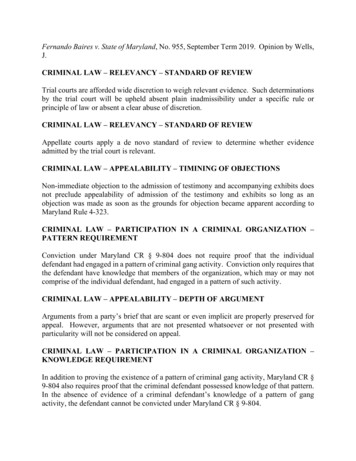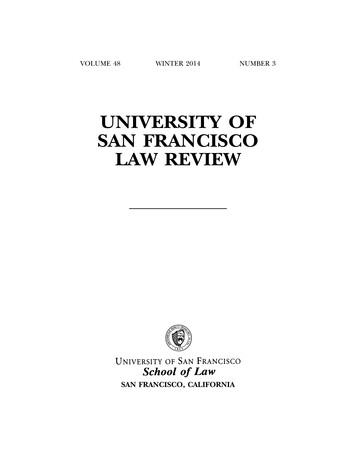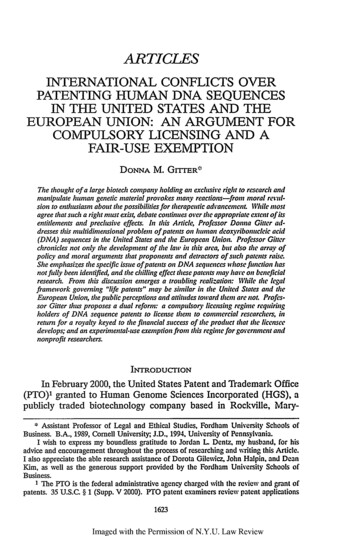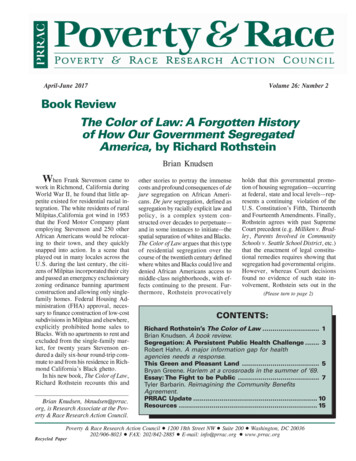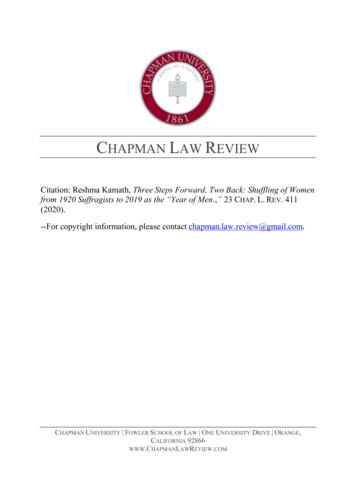
Transcription
Racial Disparities in the Capital of Capital PunishmentScott PhillipsUniversity of DenverFORTHCOMING: 45 HOUSTON LAW REVIEW (2008).AbstractDespite decades of research on race and capital punishment, “reasonably well-controlled” studieshave not been conducted in the five most active death states: Texas, Virginia, Oklahoma,Missouri, and Florida. To begin to address this limitation, the current research examines theimpact of race on the District Attorney’s (DA) decision to pursue a death trial and the jury’sdecision to impose a death sentence against adult defendants indicted for capital murder in HarrisCounty (Houston), Texas from 1992 to 1999 (n 504). The findings challenge conventionalwisdom by suggesting that the race of the defendant and victim are both pivotal in the capital ofcapital punishment: death was more likely to be imposed against black defendants than whitedefendants; death was more likely to be imposed on behalf of white victims than black victims.The black-white disparities stem from an intriguing interplay between race, the seriousness of amurder, and the stages of capital litigation. The current research also represents one of the fewattempts to extend traditional black-white comparisons to include Hispanics; no Hispanic-whitedisparities were observed. The research concludes with a call to action for scholars to initiate“reasonably well-controlled” studies in the most active death jurisdictions in the United States.Please direct correspondence to: Scott Phillips, Department of Sociology and Criminology,University of Denver, 2000 E. Asbury Avenue, Denver, CO 80208-2948, Scott.Phillips@du.edu.I am indebted to Scott Durfee, Chief Counsel to the Harris County District Attorney, whoexplained numerous office processes and provided archival data. I am also indebted to KimBohannon from the Harris County District Clerk’s office who made the research possiblethrough complete assistance with the JIMS database. I would like to thank Russ Curtis fordiscussions about capital punishment in Texas during the earliest stages of the project. Forproviding comments on drafts, I thank Paul Colomy, Mark Cooney, Jim Coverdill, David Dow,Mike Radelet, and Nancy Reichman. Most importantly, I could not have completed the projectwithout help from the following undergraduate Research Assistants: Shaefali Pillai Rogers,Breck Garrett, Mor Regev, and Ivan Zapata. The research was financed in part through fundingfrom Rice University.
2Racial Disparities in the Capital of Capital PunishmentJustice is supposed to be blind – meted out according to the legal characteristics of a caserather than the social characteristics of the defendant and victim. Decades of research on raceand capital punishment, however, demonstrate that blind justice is a mirage (United StatesGeneral Accounting Office 1990; Baldus and Woodworth 2003a, 2003b; Paternoster, Brame, andBacon 2008).Ironically, the most rigorous research on race and capital punishment has not beenconducted in the jurisdictions that execute the most offenders. In a recent comprehensive reviewof the literature, David Baldus and George Woodworth, leading scholars in the field, argue that“reasonably well-controlled” studies have been conducted in the following jurisdictions:California, Colorado, Georgia, Kentucky, Maryland, Mississippi, Nebraska, New Jersey, NorthCarolina, Philadelphia, and South Carolina (2003a:519). The list of jurisdictions with“reasonably well-controlled” studies is striking due to glaring omissions – the list does notinclude the five most active death states: Texas, Virginia, Oklahoma, Missouri, and Florida.Such states account for 719 of the 1,099 executions in the modern era, defined as the SupremeCourt’s reinstatement of capital punishment in 1976 to the present.The current paper advances the field of race and capital punishment by conducting“reasonably well-controlled” research in one of the most active death jurisdictions in the UnitedStates. To do so, I examine whether race influenced the District Attorney’s (DA) decision topursue a death trial or the jury’s decision to impose a death sentence against adult defendantsindicted for capital murder in Harris County, Texas from 1992-1999 (n 504).1Baldus and Woodworth define “reasonably well-controlled” studies as those including“statistical controls for 10 or more legitimate non-racial case characteristics” (2003a:519). Thecurrent research meets the Baldus/Woodworth standard of being “reasonably well-controlled.”To be clear, the current research does not claim to be in the same league as Baldus and1
3Though the entire state of Texas has earned a reputation for execution, Harris County –home to Houston and surrounding areas – is arguably the capital of capital punishment. With102 executions in the modern era, Harris County has often captured the national andinternational spotlight in the death penalty debate (see e.g. Amnesty International, 2007). Table1 demonstrates three compelling patterns: if Harris County were a state it would rank second inexecutions after Texas, recently passing Virginia; Harris County has executed more offendersthan all the other major urban counties in Texas, combined; and Harris County has executedmore than twice as many offenders as the top death jurisdiction that has been subject to“reasonably well-controlled” research on race and capital punishment. The period from 1992 to1999 is also critical because the number of death sentences in Harris County climbed to historichighs. From 1976 to 1991, Texas’ death row received an average of six offenders per year fromHarris County. But from 1992 to 1999, the average almost doubled to 11 offenders per year –about one a month. The average dropped to 5 offenders per year from 2000 to 2007 (TexasDepartment of Criminal Justice, 2008).2 3colleagues’ seminal research. The Baldus study remains the most rigorous research on race andcapital punishment by far, and arguably the most impressive research on any topic in the field ofCriminology.2One could argue that it is inaccurate to call Harris County the “capital of capital punishment.”In an important article that provides the first comprehensive examination of death sentences forthe entire nation, Blume and colleagues (2004) demonstrate that the death sentence rate in Texasis below the national average (the death sentence rate is defined as the number of death sentencesdivided by the number of murders). In fact, the death sentence rate in Texas ranks 16th amongthe 31 states that sent more than 10 offenders to death row from 1977 to 1999. The authors alsonote in a New York Times article that the death sentence rate in Harris County is average forTexas (Liptak 2004). Thus, the considerable number of executions in Texas is not a product of ahigh death sentence rate, but rather a large number of murders coupled with the state’spropensity to execute inmates who are sentenced to death (Blume, Eisenberg, and Wells 2004).Given Blume and colleagues’ (2004) findings, how can Harris County be called the capital ofcapital punishment? Consider the following: (1) The execution rate is arguably more importantthan the death sentence rate – a death sentence is a pivotal and crucial moment in a capital case,but execution is the quintessence of capital punishment. Calculating the execution rate revealsthat Texas catapults from 16th to 3rd in the national rankings (the execution rate is defined as the
4[Table 1 Here]To anticipate, the results challenge conventional wisdom regarding the basic relationshipbetween race and capital punishment. Conventional wisdom holds that the race of the victim ispivotal, but the race of the defendant is not (United States General Accounting Office 1990).The current research suggests that the race of the defendant and victim are both pivotal in thecapital of capital punishment: death was more likely to be imposed against black defendantsthan white defendants, and death was more likely to be imposed on behalf of white victims thanblack victims. No Hispanic-white disparities were observed.Before proceeding it is important to note that the central claim of the research – racialdisparities exist – does not insinuate that judicial actors intend to discriminate. Because humanmotivations are unobservable, scientific methods cannot be used to determine whether disparitiesare intentional or unintentional, conscious or unconscious (Black 1995). The word “disparities”is used throughout the research to denote aggregate numerical differences, while the word“discrimination” has been avoided because it unfairly impugns motives.number of executions divided by the number of murders). (2) Raw numbers and rates bothmatter. The following example from baseball illustrates the point. Barry Bonds holds the careerhomerun record at 762 even though Bonds hit a homerun in 7.7 percent of at bats (762/9,847)compared to Babe Ruth who hit a homerun in 8.5 percent of at bats (714/8,398). Ty Cobb holdsthe career batting average record at .366 even though Cobb had a total of 4,189 hits compared toPete Rose who had 4,256 hits (www.baseball-reference.com/leaders/). Bonds’ raw number ofhomeruns is not diminished by Ruth’s homerun rate, nor is Cobb’s batting rate diminished byRose’s raw number of hits. In most areas of life, including baseball and capital punishment, rawnumbers and rates both contain important information needed to determine rankings. (3) Thephrase “capital of capital punishment” is not meant to suggest that Harris County would be ratedas the most prolific death penalty jurisdiction under any possible standard. Rather, the phrase isa heuristic device used to call attention to the indisputable fact that Harris County is one of themost active death jurisdictions in the nation.3The annual number of death sentences from Harris County was calculated from the TexasDepartment of Criminal Justice website which lists the county of conviction for each offenderand the date the offender was received on death row.
5I. RACE AND CAPITAL PUNISHMENTRather than attempt to summarize the immense body of scholarship on race and capitalpunishment, the following review focuses on five issues that are relevant to the current project:(1) landmark Supreme Court cases, (2) seminal research conducted by Baldus and colleagues, (3)existing reviews of the literature, (4) prior research in Texas, and (5) the limitations of priorresearch in Texas.In Furman v. Georgia (1972), the Supreme Court ruled on a 5-4 vote that capitalpunishment was administered in an arbitrary manner that constituted cruel and unusualpunishment. Most of the justices in the majority used the word “arbitrary” to refer to numericaldisparities, arguing that there was no legal basis for distinguishing the handful of defendants whowere sentenced to death from the large number of defendants who committed equallyreprehensible crimes but were not condemned. But two justices, Douglas and Marshall, alsoused the word “arbitrary” to refer to racial disparities in the imposition of capital punishment.After the Supreme Court’s decision in Furman, states began to revise their laws andreinstate capital punishment. Some states eliminated arbitrariness by making the death penaltymandatory for defendants convicted of certain crimes. Other states adopted “guided discretion,”an approach that narrowed and specified the range of crimes eligible for death, separated theguilt and sentencing phases of a capital trial (allowing the prosecution and defense to introduceevidence of aggravating and mitigating circumstances during the sentencing phase that could nothave been introduced during the guilt phase), and required automatic appellate review of deathsentences. In Woodson v. North Carolina (1976) and the companion case of Roberts v.Louisiana (1976), the Supreme Court struck down mandatory death statutes arguing that theprotection of human dignity required individual consideration of each case. But the Supreme
6Court upheld guided discretion statutes in Gregg v. Georgia (1976) and the companion cases ofProffitt v. Florida (1976) and Jurek v. Texas (1976), beginning the modern era of capitalpunishment. Guided discretion statutes soon proliferated as states passed legislation that wouldcomply with the ruling in Gregg.Following the Supreme Court decision in Gregg (1976), social scientists began toexamine whether guided discretion eliminated the influence of race on capital punishment.Baldus and colleagues’ Procedural Reform Study (PRS) and Charging and Sentencing Study(CSS) remain the most important and rigorous research on the topic (Baldus, Woodworth, andPulaski 1990). The PRS includes 750 (156 pre-Furman and 594 post-Furman) murderconvictions in Georgia spanning 1970 to 1978, and the CSS includes 1,066 defendants convictedof murder or voluntary manslaughter in Georgia from 1973 to 1979. Both studies control for anenormous number of potential confounders. The statewide post-Furman findings reveal that therace of the defendant was not a significant predictor, but the race of the victim was crucial:defendants who killed white victims were 4.3 times more likely to be sentenced to death.Moreover, black defendants who killed white victims were more likely to be sentenced to deaththan any other racial combination.The results of the CSS, and to a lesser degree the PRS, became the basis for the mostimportant Supreme Court decision on race and capital punishment: McCleskey v. Kemp (1987).McCleskey argued that racial disparities in the administration of capital punishment rendered theultimate sanction unconstitutional. The Supreme Court did not contest the empirical patterns,but nonetheless rejected McCleskey’s challenge on a 5-4 vote. Most centrally, the court arguedthat statistical evidence of racial disparities alone, without evidence of discrimination in theparticular case at hand, does not establish a constitutional violation. The court was also reluctant
7to open Pandora’s box, reasoning that if social science research regarding racial disparitiesinvalidated capital punishment then social science research could ultimately undermine the entirecriminal justice system.Two comprehensive reviews of research on race and capital punishment have beenconducted since the Supreme Court decision in McCleskey. The United States GeneralAccounting Office reviewed the 28 studies published from 1972 to 1990, and, more recently,Baldus and Woodworth reviewed the 18 studies reported or published from 1990 to 2003 (UnitedStates General Accounting Office 1990; Baldus and Woodworth 2003a, 2003b). Both reviewsreach the same conclusion: (1) The race of the defendant does not have a consistent influence oncapital punishment: some studies suggest the disparate treatment of black defendants, but mostdo not. (2) The race of the victim has a consistent and robust influence on capital punishment:almost all studies suggest that death is more apt to be imposed on behalf of white victims.Drawing on Supplemental Homicide Reports (SHR), scholars have also examined therelationship between race and capital punishment in Texas. The SHR data are used to examinewhether race distinguishes the large number of defendants arrested for murder from the smallnumber sentenced to death. The post-Furman findings in Texas mirror established patterns: therace of the defendant does not seem to matter; death is more apt to be imposed on behalf of whitevictims; and minorities who kill whites are more apt to be sentenced to death than any otherracial combination (Bowers and Pierce 1980; Ekland-Olson 1988; Sorensen and Marquart 19901991; Marquart, Ekland-Olson, and Sorensen 1994; Brock, Cohen, and Sorensen 2000; for preFurman patterns see e.g. Koeninger 1969; Ralph, Sorensen, and Marquart 1992; Hunter, Ralph,and Marquart 1993).
8Existing research in Texas suffers from five important limitations, most of which stemfrom a reliance on SHR data: (1) SHR data cannot control for critical confounders such as thedefendant’s prior criminal record or the heinousness of the crime. Hence, no study in Texasmeets the Baldus/Woodworth standard for “reasonably well-controlled” research enumeratedabove. (2) SHR data cannot isolate murder defendants who were eligible for capital punishmentunder Texas law, so the imperfect comparison includes defendants who were not eligible fordeath and/or excludes defendants who were eligible for death. (3) If racial disparities emerge,SHR data cannot identify the stage of the process that produced the disparities. Disparities mayoriginate in the decision to charge a defendant with capital murder, the decision to indict adefendant for capital murder, the DA’s decision to pursue a death trial, or the jury’s decision toimpose a death sentence. (4) SHR data are sometimes problematic due to missing values. (5)Existing studies tend to examine the entire state of Texas (for an exception see Brock, Cohen,and Sorensen 2000). Because capital punishment in Texas is the aggregation of capitalpunishment in 254 counties with different histories, cultures, political climates, and legal actors –including different DA’s who decide whether to pursue a death trial – an investigation of raceand capital punishment across the state of Texas cannot account for local conditions.The current research overcomes such limitations by: controlling for critical confounders,focusing exclusively on defendants who were eligible for death, identifying the stage of theprocess that produced racial disparities, including complete data for all cases, and examiningpatterns for a single county.
9II. RESEARCH METHODSA. Dependent Variables: Trajectory and DispositionIn Harris County, the path from the commission of a murder to the pronouncement of adeath sentence includes four major decisions: the intake prosecutor’s decision to charge adefendant with capital murder, the grand jury’s decision to indict a defendant for capital murder,the District Attorney’s decision to pursue a death trial, and the jury’s decision to impose a deathsentence. Because the charging and indictment decisions do not appear to exhibit enoughvariation to warrant an investigation, the current research focuses on whether race influenced theDA’s decision to pursue death or the jury’s decision to impose death – the trajectory anddisposition of a case.4 5 6The data include the population of adult defendants indicted for capital murder inHarris County, Texas from 1992 to 1999 (n 504).7 The Harris County District Clerk (HCDC)used the Harris County Justice Information Management System (JIMS) to identify the4John Holmes Jr. was the DA in Harris County during the time period under consideration.The Harris County intake division prosecutor must determine whether a homicide can becharged under the Texas capital murder statute. Despite repeated attempts, collecting the dataneeded to examine the impact of race on the charging decision proved impossible. But thecharging decision does not appear to exhibit much variation. To begin, the Texas capital murderstatute delineates narrow categories of murder that are death-eligible. The precision of thestatute simplifies the charging decision, as opposed to states that define heinous murders as deatheligible (see Texas Penal Code, title 5, chapter 19, section 19.03). Moreover, The HoustonChronicle reports in a February 2001 special series that the intake prosecutor has “standingorders” to file capital murder charges in all possible cases (Tolson and Brewer, February 4,2001:A1; the remaining segments in the special series are listed in the reference section for theinterested reader). Nonetheless, the inability to examine the charging decision remains apotential weakness of the current research.6The grand jury must return a “Bill of Indictment” for capital murder in order for the DA topursue a death trial. This step borders on a formality, as data from the Harris County districtclerk indicate that grand juries returned a “No Bill” in ju
Apr 29, 2008 · impact of race on the District Attorney’s (DA) decision to pursue a death trial and the jury’s . I thank Paul Colomy, Mark Cooney, Jim Coverdill, David Dow, Mike Radelet, and Nancy Reichman. Most importantly, I could not have completed the project without help from the following u






